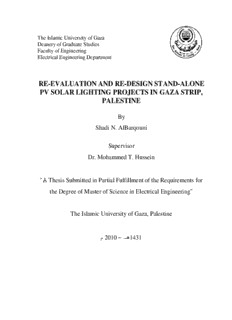
re-evaluation and re-design stand-alone pv solar lighting projects in gaza strip, palestine PDF
Preview re-evaluation and re-design stand-alone pv solar lighting projects in gaza strip, palestine
The Islamic University of Gaza Deanery of Graduate Studies Faculty of Engineering Electrical Engineering Department RE-EVALUATION AND RE-DESIGN STAND-ALONE PV SOLAR LIGHTING PROJECTS IN GAZA STRIP, PALESTINE By Shadi N. AlBarqouni Supervisor Dr. Mohammed T. Hussein “A Thesis Submitted in Partial Fulfillment of the Requirements for the Degree of Master of Science in Electrical Engineering” The Islamic University of Gaza, Palestine م 2010 – ــه1431 ii Recently, with the critical situation of siege on Gaza Strip, the need of an alternative energy source instead of traditional energy sources becomes an urgent need, especially Palestine is considered one of the sunny countries and percepts good solar radiation over the year. In this research; the re-evaluation and re-design of a reliable control system process were analyzed step by step, beginning with modeling the global solar radiation passing through orientation and tilting, ending to PV and Battery sizing. This thesis evaluates the previous lighting project implemented in Gaza Strip, and focuses on the critical drawbacks which are not considered in the existence design. The research results were tested by the utilization and implementation of an experimental solar model for lighting an apartment to validate the proposed solar control system taking into account the IEEE Recommendations. Recommendations for Building Integrated Photovoltaic (BIPV) Designers and consultants are mentioned here to be considered for next solar projects and related studies. iii ثحبلا صخلم ةجاحلا تريظ ماوعأ ةعبرلأا براقي ام ذنم ةزغ عاطق ىمع ضورفملا راصحلاو جرحلا عضولا عم ررا متسا عم ًاصوصخو ًاحمم رملأا اذى حبصأو ،ةيديمقتلا ةقا طلا نم ًلادب ةقاطمل ليدب ردصم ىلإ .ةزغ عاطق نع تاقورحملا كلذكو ةيئابريكلا ةقاطلا عاطقنا يتلا ةرانلإا عيراشمل ةيسدنى مكحت ةمظنأ ميمصتو مييقت ةداعإ ىلإ ةيثحبلا ةسرا دلا هذى فديت ثيح نيطسم ي يسمشلا عاعشلإا ةجذمن نم ً اددب ايميمحتو ةريخلأا ةنواا ي ةزغ عاطق ي ايقيبطت مت مت ثيح ،ةيسمشلا ايلاخلاو تايراطبلا ميمصتب دايتناو ةيسمشلا ةيمخمل ةلاملإاو ويجوتلا ةيمىأب رًاورم ً .اييمع بمغتلا ةيفيكو ةقباسلا ميماصتمل ةمساحلا تايبمسلا ىمع زيكرتلا ايلاخلا للاخ نم ةقش ةداضلإ )يسدنى مكحت جذومنك( ةيممع ةبرجت ثحابلا دعأ ضرغلا اذيل دابريكلا يسدنيم ةيعمج لبق نم ةحرتقملا تايصوتلاو ريياعملا رابتعلاا نيعب ذخأ عم ةيسمشلا IEEE .) ( ةيملاعلا تاينورتكللااو ةيممع سسأ ىمع ةيجينم تاسرا دو جئاتن عضوب ةسرا دلا هذى للاخ نم ثحابلا صمخ ثيح .ةيمبقتسم عيراشم ميمصت دنع اينم ةدافتسلال اذى ي وتايصوت نم ةدافتسلااب عيراشملا هذى ررا غ ىمع نومئاقلاو نويراشتسلاا ثحابلا يصويو ةيسمشلا ةقاطلا ي مكحت ةمظنأ عيراشمل ميمصتلا لاح ي رابتعلاا نيع ي ايب ذخلأل لاجملا .لابقتسم iv To my parents, my darling who have been a constant source of motivation, inspiration and support. v I would like express my thanks to many people who have contributed to the success of this research, in particular my thesis supervisor Dr. Mohammed T. Hussein, for his support, encouragement, and continuous follow-up of this research. I would like also to extend my gratitude and appreciation to thesis committee, both Prof. Dr. Mohammed Abdelati and Dr. Anwar Abu Zarifa for their suggestions and recommendations that helped with the development of this research, greeting to Dr. Mahir Sabra for his support. Special thanks to the Engineers and Consultants in Authority of Energy, who helped me in this research, also special thanks to El-Wafa Charitable Society in Gaza City for their partial financial support to this project. Special greetings to my family, especially my parents, who have always kept me in their prayers, who have suffered a lot to make me happy. vi iii v vi x xi 1 1 1.1.1 Biomass Energy 1 1.1.2 Wind Energy 3 1.1.3 Geothermal Energy 4 1.1.4 Photovoltaic Solar Energy 5 7 1.2.1 PV Modules 8 1.2.2 Controllers 8 1.2.3 Batteries 8 1.2.4 Safety and Maintenance 8 1.2.5 Cost vs. Quality 8 10 1.3.1 Modeling of Global Radiation Model 10 1.3.2 Orientation and Tilt Angles 10 1.3.3 PV system Model 11 1.3.4 PV Modules, Batteries, MPPT Controllers and Regulators 11 1.3.5 Maintenance and Monitoring 12 12 13 14 14 vii 14 15 2.3.1 Data 15 2.3.2 Description of the Model 16 2.3.3 MATLAB Program 18 18 22 23 23 23 25 3.3.1 Definition of Angles 25 3.3.2 Derivation of Solar Angle cosθ (sinα ): 27 s s 3.3.3 Derivation the Optimum Tilt and Azimuth angles for the Solar Plate 29 3.3.4 Computing the Solar Angle cosθ 30 s 3.3.5 Enhancement on the Optimum Values 31 33 36 38 38 38 4.2.1 Crystalline silicon PV modules 38 4.2.2 Amorphous silicon (a-Si) PV modules 40 4.2.3 Copper indium diselenide (CIS) PV modules 40 4.2.4 Cadmium telluride (CdTe) PV modules 41 4.2.5 Heterojunction with intrinsic thin layer (HIT) PV modules 41 42 4.3.1 Capacity 42 viii 4.3.2 Type 42 4.3.3 Cyclability 43 44 4.4.1 Shunt Regulator 44 4.4.2 Series Regulator 44 4.4.3 PWM Regulators 45 4.4.4 MPPT Controllers 46 47 50 51 51 52 5.2.1 Orientation and Tilt angle 52 5.2.2 Calculating Load Consumption 52 5.2.3 PV Components 53 56 5.3.1 PV and Battery Sizing 56 5.3.2 Cost Estimation 57 5.3.3 Conclusion 58 59 59 Conclusion 59 60 61 65 65 68 72 ix Table 2.1: Location of stations and period of observation of global solar radiation 15 Table 2.2: Input Parameters for Angstrom's Equations 19 Table 2.3: Comparison between the observed and estimated global solar radiation for Gaza Strip 20 Table 2.4: Deviations between the estimated model and the observed global solar radiation data 21 Table 3.1: Mean values of solar angles for different tilt and azimuth angles 31 Table 3.2: Comparison between current and optimum orientation 34 Table 3.3: Comparison between various orientations 36 Table 4.1: Difference of Sizing Summery between current and recommended designs with same 50 and different selected batteries and modules Table 5.1 : Apartment Electrical Load 53 Table 5.2: Sizing Summery for an Apartment 57 Table 5.3: Sizing Summery for proposed model 57 Table 5.4: Comparison for cost estimation between available source energy for home user 58 x
Description: